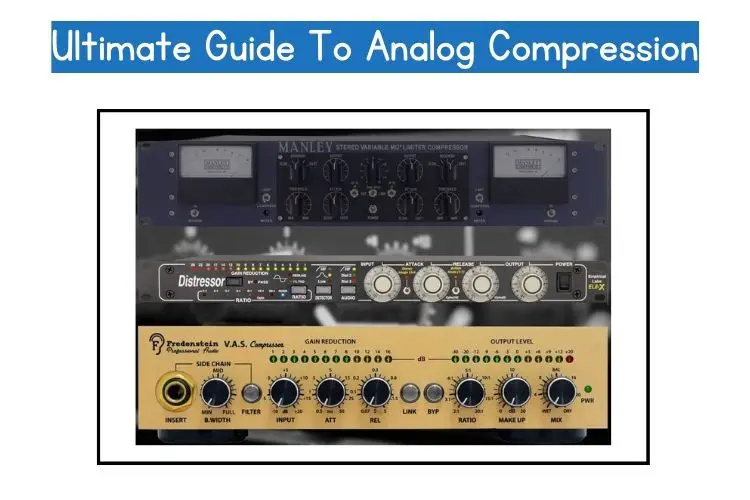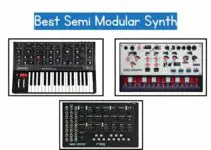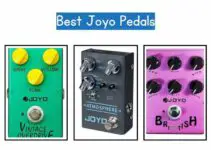Compression has always been and will always be a very important aspect of audio production and mixing. Compression evens out the dynamic range of an audio signal in such a way that the very loud parts are tamed and the quiet parts are compensated with appropriate loudness.
Managing dynamics in a mix is one of the most important aspects of mixing audio. Imagine an audio signal having a very quiet (not very loud) part and also a very loud part, it will be quite easy for the very loud part to overshadow the quiet part.
Let’s imagine you are listening to an audio file that is uncompressed and with a wide dynamic range. You might need to manually bring up the volume of your device when the very quiet part plays. Also, you will need to bring down the volume when the loud part comes up.
That doesn’t sound quite fun, right? This is what compression does for you. It makes use of parameters like ratio, attack, and release to achieve this smoothing and levelling effect.
Compression, although one of the most widely used concepts in audio still remains one of the least understood. But the sad news is that this is not an article on how compressors work.
To fully understand how compressors work and how to use them, one will need to undergo extensive and dedicated studies on audio compression. That being said, this article is about analogue compression and how it is different from digital compression.
Considering that this is one of the most widely talked about concepts in audio compression, it only makes sense that we go deeper into the concept of analogue compression and demystify some things.
Analogue compressors are basically hardware compressors that affect an audio signal using analogue circuits like tube or optical circuits, to compress the said audio signal.
Table of Contents
Analogue Compression – The Concept
Let’s start by understanding what analogue means. analogue, in terms of Audio, means that there is an ‘analogue’ relationship (similar, closely related) between the origin of the sound and the carried signal, which is literally an electrical current across all its journey.
Picture it like this: when you play a note on an electric guitar, there is a sound produced by the strings vibrating. That oscillation is caught by the pickups and transduced to magnetic oscillation and then to electrical current.
Once it is converted to electrical current, in an analogue environment, it remains electrical current until just before it is heard – why just before it is heard? Because our ears are not made to perceive electrical current but are made to perceive sound, electrical current is transduced back to sound in this stage.
Now, in a Digital environment, after the sound waves are transduced to an electrical signal, it is converted by the famous A/D converters to bits (0s and 1s). So there is no similarity between the sound waves made by the guitar, and the 0s and 1s.
In an analogue environment, the voltage ‘oscillates’ in a similar way to the sound waves produced by the guitar; they follow the same oscillating ‘movement.’
If I asked you: “In principle, what signal do you think will be more ‘rich’ and more exciting? One made by electrical current travelling through different components or one converted to 0s and 1s?”
What would your answer be? Well, in principle, in general, the audio community agrees that the analogue signal is way more rich and exciting than a digital one.
It has to do with the randomness that electrical components add to the signal, the pleasant dose of ‘noise’ and dirt that electrical processors add to the signal and more.
This gives analogue equipment the capacity to play with different colours, tones, warmth and characters that make the analogue world a beautiful one to explore!
4 Types of Analogue Compressors and How They All Work
FET Compressors
Field Effect Transistor (FET) compressors are known for their aggressive sound and fast attack times.
They use a FET circuit to control the level of gain reduction, which reacts proportionally to the input signal. This results in a more natural and transparent compression. The most famous example of a FET compressor is the Universal Audio 1176.
VCA Compressors
Voltage Controlled Amplifier (VCA) compressors are versatile and precise. They use a voltage-controlled amplifier to adjust the level of the signal. The amount of compression is determined by the control voltage, which is derived from the input signal.
VCA compressors are known for their transparent sound and are often used in mastering. The SSL G-Series Bus Compressor is a well-known example of a VCA compressor.
OPTO Compressors
Optical (OPTO) compressors use a light-sensitive resistor and a small light source (LED or electroluminescent panel) to control gain reduction. The input signal drives the light source, and the light-sensitive resistor determines the amount of compression based on the intensity of the light.
OPTO compressors are known for their smooth, musical compression and slower response times, making them great for vocals and bass. The Teletronix LA-2A is a classic example of an OPTO compressor.
Vari-Mu Compressors
Vari-Mu compressors use vacuum tubes to control gain reduction. The term “Vari-Mu” is derived from “variable μ,” where “μ” stands for gain (it’s a Greek letter). As the input signal increases, the bias on the vacuum tube changes, reducing the gain.
Vari-Mu compressors are known for their warm, smooth, and dynamic compression, making them popular for mastering and bus compression. The Manley Vari-Mu is a popular example of this type of compressor.
Analogue vs Digital Compressors – How Different Are They?
Diving deeper into the comparison between how each signal processing method affects the final result, we have to start by saying that technology nowadays is evolving extremely fast.
It has gotten to a point where it is hard to keep up with all the new tools and software that succeed in the market each month (even more with the explosion of AI-based technologies).
We say this because ten years ago (or less), the analogue compressors simply delivered a result that was not within the reach of Digital ones. You could not emulate or imitate the sound of analogue equipment in the box (inside your computer) and a trained ear could surely identify the difference. Now, in 2023, it’s a bit of a different story.
While serving the same fundamental purpose of controlling the dynamic range of an audio signal, analogue and digital compressors have distinct characteristics that set them apart.
analogue compressors, often revered for their ‘warm’ and ‘organic’ sound, operate in the physical realm. As we’ve explained before, they use electronic circuits to manipulate the audio signal.
This process introduces subtle distortions and colourations to the sound, which are often described as adding ‘character’ or ‘richness.’ These unique sonic qualities have made analogue compressors a staple in recording studios for decades.
Furthermore, no two analogue compressors are equal, since the little differences in the manufacturing of the components make subtle differences even between the same models.
On the other hand, digital compressors exist in the realm of software and manipulate audio signals mathematically. They offer a level of precision and consistency that analogue compressors can’t match.
Digital compressors can precisely replicate their settings every time, making them ideal for situations requiring repeatability. But this can take away a little bit of the unpredictability factor that can sometimes add value and beauty to our mixes.
However, the debate between analogue and digital is not a matter of better or worse, but rather a question of different flavours. The choice between the two often comes down to the specific needs of the project and the personal preference of the engineer.
Here’s a fun challenge to see if you can spot the difference between analogue and digital, often referred to as ‘Plugins’ (not limited to compressors), and two other great videos:
Pros and Cons of Digital Compression
Digital compressors offer a range of advantages. They are typically more affordable and accessible than their analogue counterparts. They also provide a high degree of control and precision, allowing for consistent results.
Furthermore, digital compressors often come with a variety of features and presets that can help streamline the mixing process. They are easier to use because they’re usually integrated as plugins to your favourite DAW, and obviously, they present no portability challenges.
Also, as we mentioned before, new technologies make an effort to imitate the randomness and the ‘x-factor’ an analogue compressor has, and this has become very popular lately, delivering impressive results.
Nevertheless, digital compressors also have their drawbacks. Some critics argue that they lack the ‘warmth’ and ‘character’ that analogue compressors bring to the table.
Pros and Cons of Analogue Compressors
Analogue compressors are often praised for their unique sonic characteristics. They can add a certain ‘warmth’ or ‘colour’ to the sound that is difficult to replicate digitally.
Many engineers also appreciate the tactile experience of using physical knobs and switches, instead of just moving an inert mouse. Analogue compressors also come with their own set of challenges.
They are generally more expensive and less accessible than digital compressors. Also, consider that the effects of an analogue compressor on a recorded signal are permanent.
Once you record with a compressor in your chain, you can’t undo it. They also require more maintenance and can be less reliable over time.
Furthermore, analogue compressors lack the convenience features of digital compressors, such as presets and undo functions. Also, it’s quite inconvenient to take them along on trips.
Audio Compressor Settings
A Compressor has many settings and parameters that can be adjusted to produce diverse results. Each of these affects the signal in a different way, and the sum of all the settings and how they interact, make the essence of compression.
Let’s start by talking about the ratio and threshold. The ratio defines what amount of the signal will be compressed when the threshold is surpassed. Simply put, it’s like an instruction that says:
“Whenever the signal is above this level (the threshold, in dB), reduce the amplitude of the signal this much (the ratio, in terms of x:1).” For instance, a ratio of 4:1 means that for every 4 dB, the input signal exceeds the threshold, the output signal will only increase by 1 dB.
This is the fundamental principle of compression, which allows us to control the dynamic range of an audio signal. For example, if the threshold is set at -10dB and the input signal rises to -6dB (4dB over the threshold), the compressor will reduce the output level such that it only rises to -9 dB.
Now, the attack might be one of the most overlooked parameters in compression, and probably the most important one. Why? Because it can influence the transients and the ‘micro-dynamics’ of a sound.
The attack time in a compressor determines how quickly the compressor responds once the input signal exceeds the threshold. Transients are the initial high-energy burst of sound at the beginning of a waveform, such as the initial hit of a drum or the pluck of a guitar string.
They are crucial for the perception of rhythm and musical articulation. If the attack time is set too fast, the compressor will clamp down on these transients immediately, which can cause the sound to lose its punch and feel lifeless or flat.
On the other hand, if the attack time is set too slow, the compressor might not react quickly enough to control loud peaks, which could lead to distortion or a sound that is too dynamic.
So, setting the right attack time is a delicate balance and can greatly influence the character and feel of the sound. It’s an essential parameter to understand and use effectively when working with audio compression.
Finally, the release is similar to the attack, but instead of defining when the compressor starts to modify the signal, it defines when it stops. After the sound goes back below the threshold, the compressor can still have an effect on the sound making the ‘tail’ of the compressing effect vary, be more smooth, more aggressive, etc…
Some compressors have other parameters such as makeup gain and more, but we’ll stick to the basics in this article.
When Should You Use An Analogue Compressor?
Although there are no fixed rules as to when to use analogue compressors, many producers will agree that they should be used when you’re aiming to add a certain character or warmth to the sound.
These compressors are known for their ability to introduce harmonic distortion, which can make the audio sound more musical, rich, or full. Analogue compressors are particularly useful when recording or mixing.
During recording, they can help control the dynamics of performance in real-time, thereby preventing unexpected peaks from causing distortion. This is especially beneficial when recording vocals or instruments with a wide dynamic range.
In the mixing stage, analogue compressors can be used to shape the tone and dynamics of individual tracks or the mix as a whole. They can add punch to drums, sustain to guitars, or smooth out vocals.
The unique sonic characteristics of different analogue compressors can also be used creatively to enhance the vibe or style of a mix.
On the other hand, it’s important to remember that analogue compressors require a good understanding of compression parameters to be used effectively. They also require more setup and maintenance compared to digital compressors.
But for those seeking the distinctive sound and tactile experience of analogue gear, they can be a game changer.
Popular Mixes and Songs Compressed With analogue Compressors
Here we present you a few songs that were produced using an analogue compressor in the compression stage. It’s not always obvious or easy to tell the difference but here’s another video that will be useful to train your ear:
A few examples from two of Daft Punk’s albums called ‘Homework’ and ‘Discovery’:
Deadmau5 is also known for using the API 2500 Stereo compressor:
Here’s a video where a producer is using the legendary Neve compressor to master a mix:
Also, check this one out!
Best analogue Compressors for Vocals, Drums, Bass, Guitar and Mastering
Here are some of the best analogue compressors for various instruments and mastering.
Vocals
For vocals, the Warm Audio WA-2A Tube Opto Compressor is a great choice. It offers smooth, vintage-style compression that enhances vocal performances, adding depth and presence. The tube-based circuitry provides a warm, rich tone that’s perfect for vocals.
Drums
The Empirical Labs Distressor EL8X is a versatile compressor that shines on drum tracks. It offers a wide range of controls for shaping the dynamics of your drum sounds, from subtle smoothing to aggressive squashing.
The added “British Mode” provides the classic over-compressed sound of vintage British consoles.
Bass
The dbx 160A is a classic compressor for bass. It provides a tight, punchy compression that helps bass tracks stand out in the mix.
The over-easy compression technology ensures smooth performance, while the auto dynamic attack and release controls allow for the precision shaping of your bass sound.
When we talked about attack and release we mentioned what these parameters do. When you find ‘auto,’ ‘dynamic’ or ‘smart’ on your gear, it is set automatically based on the input level.
Guitar
The Universal Audio 1176LN is a legendary compressor that’s perfect for guitars. It offers fast attack times and rich tonal colouration, enhancing the natural characteristics of the guitar.
The all-button mode, also known as “British Mode,” provides a unique, overdriven compression effect that’s great for creative sound shaping.
Mastering
For mastering, the Manley Variable Mu Limiter Compressor is hard to beat. It offers exceptional sonic quality and precise control, making it ideal for refining the dynamics of your final mix.
The Variable Mu design provides a smooth, transparent compression that preserves the musicality of your tracks while ensuring they’re ready for commercial release.
Conclusion
The world of audio compression is a vast and fascinating one, with analogue and digital compressors each offering their unique strengths and characteristics.
Analogue compressors, with their physical circuits and components, bring a certain ‘soul’ to the audio processing realm; a warmth, richness, and character that analogue gear imparts to the sound.
It is the subtle distortions, the pleasant dose of ‘noise,’ and the unique colourations that make each analogue compressor a unique entity, much like a living being with its own personality.
The concept of a ‘soul’ in analogue compressors is not about spirituality, but rather about the unique, unpredictable, and often desirable sonic characteristics that these devices introduce to the audio signal.
It is about the way they interact with the sound, the way they respond to the dynamics of the music, and the way they shape the tone and texture of the audio. It is about the sense of life, energy, and musicality that they bring to the sound.
Digital compressors, while offering precision, consistency, and advanced features, often lack this factor, given their nature of being a program.
They can replicate their settings perfectly every time, but, in general, they can’t replicate the unique sonic fingerprints that analogue compressors leave on the sound.
They can’t replicate the subtle variations, the random fluctuations, and the organic feel that analogue compressors bring to the table.
In the end, the choice between analogue and digital compression is not a matter of superiority, but a matter of preference, context, and desired result. It’s about choosing the right tool for the job.





